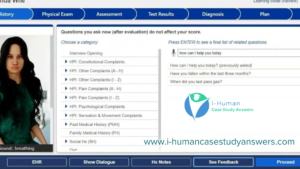Samantha Graves is an 18 month old female with a two day history of diarrhea and vomiting. She has had 4-5 episodes of non-bilous emesis per day. She has also had 3 episodes of runny, watery stools per day. Her appetite has decreased but she has been tolerating small amounts of pedialyte and milk. She has had a slightly decreased amount of wet diapers. She has no signs of dehydration on physical exam and is alert and active.
Samantha Graves iHuman Problem Statement
Samantha, an 18-month-old female, presents with a two-day history of diarrhea and vomiting. She has experienced multiple episodes of non-bilous emesis and runny, watery stools each day. Her appetite has decreased, but she has been able to tolerate small amounts of pedialyte and milk. Additionally, there is a slight decrease in the number of wet diapers. Despite these symptoms, Samantha shows no signs of dehydration on physical examination and remains alert and active.
Problem Statement
Samantha Graves presents with acute gastrointestinal symptoms, including diarrhea and vomiting, accompanied by decreased appetite and slightly reduced urine output. The primary concern is to determine the underlying cause of her symptoms and ensure appropriate management to alleviate her discomfort and prevent dehydration.
This problem statement provides a clear overview of Samantha’s presenting symptoms, highlighting the need for further investigation to identify the etiology of her gastrointestinal issues and address any potential complications such as dehydration. It serves as a guide for the subsequent steps in the diagnostic process and the development of an effective treatment plan for Samantha.
Samantha Graves iHuman Case Plan
To develop a comprehensive care plan for Samantha Graves based on the given information, we can consider the following steps:
1. Assessment and Diagnosis:
- Conduct a thorough physical examination to assess Samantha’s overall condition and identify any specific symptoms or abnormalities.
- Perform diagnostic tests, such as blood work and stool analysis, to evaluate for possible causes of her gastrointestinal symptoms.
- Consider differential diagnoses, including viral or bacterial gastroenteritis, food intolerance, or other gastrointestinal disorders.
2. Treatment and Management:
- Focus on supportive care to alleviate Samantha’s symptoms, such as providing fluids to prevent dehydration and adjusting her diet to accommodate her decreased appetite.
- Administer antiemetic medication to control vomiting if necessary.
- Educate Samantha’s parents on proper hygiene practices and the importance of handwashing to prevent the spread of infection.
- Monitor Samantha’s fluid intake, urine output, and overall condition closely.
3. Follow-up and Monitoring:
- Schedule a follow-up appointment to assess Samantha’s progress and evaluate the effectiveness of the treatment plan.
- Adjust the care plan as needed based on the results of diagnostic tests or any changes in Samantha’s condition.
- Provide ongoing support and guidance to Samantha’s parents to ensure proper management of her symptoms at home.
By following this case plan, healthcare professionals can address Samantha’s immediate needs, manage her symptoms effectively, and work towards resolving the underlying cause of her gastrointestinal issues. Regular monitoring and communication with her parents are essential to track her progress and make any necessary adjustments to the care plan.
Samantha Graves iHuman Care Plan
Patient: Samantha Graves Age: 18 months
Assessment:
- Chief Complaint: Two-day history of diarrhea and vomiting.
- Vital Signs: Within normal range.
- Stool Characteristics: Runny, watery stools.
- Appetite: Decreased but tolerating small amounts of pedialyte and milk.
- Urine Output: Slightly decreased wet diapers.
- Physical Exam: No signs of dehydration, alert and active.
Nursing Diagnosis: Fluid Volume Deficit related to diarrhea and vomiting as evidenced by decreased urine output and decreased wet diapers.
Goals:
- Maintain adequate hydration and prevent dehydration.
- Alleviate gastrointestinal symptoms and promote comfort.
- Monitor for complications and intervene promptly.
Interventions:
- Assess vital signs, including temperature, heart rate, and blood pressure, at regular intervals.
- Offer small, frequent sips of oral rehydration solution (e.g., Pedialyte) to replenish lost fluids and electrolytes.
- Monitor and record intake and output, including urine output and number of wet diapers.
- Provide age-appropriate, easily digestible foods (e.g., rice, bananas, toast) to gradually restore the appetite.
- Administer antiemetic medication as prescribed to alleviate vomiting.
- Maintain a clean and hygienic environment to prevent the spread of infection.
- Educate parents on proper hand hygiene and encourage them to monitor Samantha’s fluid intake and output.
- Monitor for signs of dehydration (e.g., dry mucous membranes, sunken fontanelle) and report any changes promptly.
Evaluation:
- Patient’s hydration status improved as evidenced by increased urine output and wet diapers.
- Gastrointestinal symptoms, including vomiting and diarrhea, decreased over time.
- Patient and family demonstrated understanding of home care measures to prevent dehydration and promote recovery.
Note: The above care plan is for illustrative purposes only. It is important to consult with a healthcare professional or follow institutional guidelines for specific care plans tailored to individual patient needs.

